
Miami Beach A History of Boom to Bust to Boom
Nancy Liebman
Miami Beach City Council
![]()

Miami Beach A History of Boom to Bust to Boom
Nancy Liebman
Miami Beach City Council
![]()
Miami Beach re-discovered its true wealth--and its identity--by defeating the blind greed of an old city hall establishment. |
Posted 23 April 1997
 Nancy Liebman |
Miami Beach's development has been a series of successes, crashes, and rebirths. The city's earliest development began with avocado farms, coconut plantations, a wooden bridge from the Miami mainland, grand hotels, and a tourist boom--but then came the disruptive hurricane of 1926. By the 1930s, as the country was recovering from the Great Depression, Miami Beach was well on the road to new speculation and the building of a modern 20th Century Tropical Deco resort area. The trend continued until World War II, when the Army Airforce took over the booming little resort area. Following the war, Miami Beach was the symbol of glitz and glamour for the tourist industry. A new hotel was built every year throughout the 1950s and early 1960s. Subsequently, a wave of condominium high-rises replaced the elegant estates in an effort to bring retirees to the city for year-round housing. |
| By the 1970s new resorts and jet service had diminished Miami Beach's image as a tourist destination. As tourism waned, the city turned its attention to expanding its convention center. As the hotels lost business, they fell on hard times and neglect, especially in the older neighborhoods of South Beach. By the 1980s, the Mariel Boat Lift had brought a horde of new people to Miami Beach, some of whom were honest and hard-working and others who became part of the criminal element that gravitated to the troubled neighborhoods. Desperate property owners and a negligent city allowed the city to crash. I call this the Third Bust. The 1990s are a period of boom, as the city is experiencing its third renaissance. Ironically, the rebirth of the city is based upon the revival and restoration of its earliest neighborhoods. |
| The Historic Preservation Movement: The Revival Of A City | |
| The only results of the failed revitalization plan were lawsuits that put the city in great jeopardy and a neglected neighborhood. | A failing Redevelopment Agency with a scheme to turn Miami Beach's oldest neighborhood into a canal-filled new city met headlong with a fledgling preservation organization in 1976, the year the Miami Design Preservation League was founded. While the city's leaders worked to maximize zoning, condemn properties, thwart improvements to existing building stock, and schemed to disembody a neighborhood, the Preservation League went to work to place the 1920s, 1930s and 1940s Tropical Deco signature statement architecture onto the National Register of Historic Places. In 1979, the Art Deco District was placed on the Register despite the city government's objections. The city leadership continued to court a failing urban revitalization scheme that had been organized by a failing Redevelopment Agency. The only results of the failed revitalization plan were lawsuits that put the city in great jeopardy and a neglected neighborhood. The collapse of the neighborhood took place as a result of a building moratorium which had been designed to drive residents out and lower the values of properties ripe for condemnation. The National Register designation of the neighborhood to the north of the Redevelopment Area was not recognized as an asset by the city, and the efforts to preserve, protect, and promote it became a thirteen-year battle in the city. |
| The City's Long Climb To Its Third Boom: A New Vision | |
| After the National Register Designation in 1979, the Preservation League created an Art Deco District Preservation Plan, a vision and a guide to preserving, protecting, marketing, promoting, and creating infill for the designated district. The Plan was never adopted or recognized by the City leadership. In retrospect, the Plan was actually a portent, as it mentioned many of the events that have actually occurred since that time. | |
| The changes occurred one small step at a time. | The League followed the model of the Plan. The grassroots efforts included marketing and promoting, establishing an economic arm for development and restoration, learning grantsmanship, lobbying for preservation laws to both prevent demolition and establish a design review process, and creating media relations to help win over an intransigent City government. The changes occurred one small step at a time, and it was a challenge to create the local legislation necessary to protect the integrity of the one-square-mile neighborhood. The City's leadership establishment rejected any historic preservation overlay legislation. A lawsuit by Dade County finally overturned the City's resistance, but only with a change in political leadership in the early 90s did the battles turn to successes. |
| The Grand Compromise: Developer Jets Preservationist | |
| While the Preservation League was steadfast in its vision to protect the National Register Art Deco District, the City's leadership continued to support the Redevelopment Agency's Revitalization Plan. The leadership feared preservation protection for the historic neighborhood because they wished to build a new convention center hotel in the area on the ocean near the Miami Beach Convention Center. The Convention Center had been expanded as a fix for the lagging tourist industry, but now the City needed a new hotel to serve it. With the Second Bust of the city in the 1970s and 1980s and a dead hotel market, the city had not had a new hotel in 20 years. | |
| The City leadership did not understand the growing phenomenon of a re-energized Art Deco District and wished to build the new hotel by condemning property on the northern edge of the designated National Register District. The preservationists prevailed upon the City administration to hire an architectural consulting firm to demonstrate to the public that a new convention hotel could be designed that would incorporate historic buildings into a plan for new compatible construction. This construction would be in keeping with the existing scale of the neighborhood and sympathetic with the pedestrian quality of the Art Deco District. The study concluded with a plan that was accepted by the preservationists, developers, hoteliers, and the tourism convention industry. The new hotel, Loews Miami Beach, will open in 1998. | |
| It was a time of new acceptance for the preservation ethic in Miami Beach. | The grand compromise limited the scale of the new construction but also allowed for certain portions of historic buildings to be demolished. It was a time of new acceptance for the preservation ethic in Miami Beach. The entire boundary of the National Register District was finally protected with local preservation legislation in 1992, two years after the compromise had been reached. |
| The Vision Creates A New City: The Art Deco District Becomes An International Tourist Phenomenon, A Cultural Mecca And Home To A Growing Film, Fashion, Production, Entertainment, And Music Industry | |
| I will use this section to show a series of slides outlining the beginnings of the successful restoration of the historic district. The slides are organized in the following categories: | |
| The earliest 1920s Mediterranean and Mission style architecture.
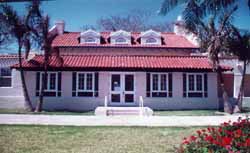 |
|
| Whimsical structures of the 1930s through the 1940s, including the faux federalist style such as
the Betsy Ross, Jefferson, and White House created during the Second World War.
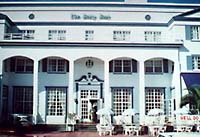 |
|
|
Selected architectural features that distinguish the human-scale buildings and are described in
the nomination as significant to the district as listed on the National Register.
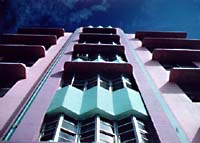
|
|
| Early restoration projects and projects showing restoration and new construction.
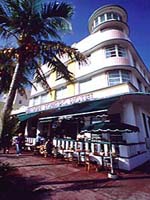 |
|
| Restoration in the residential neighborhoods.
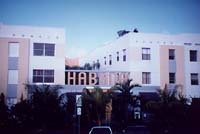 | |
| New restaurants, the cultural renaissance, and the growth of the film, fashion, and entertainment
industry.
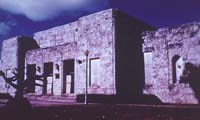
| |
| The adaptive reuse of historic buildings as a commercial base.
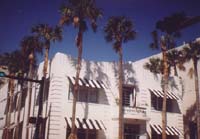
| |
| Non-success stories and the areas that almost got away, including Lincoln Road and the Museum
District.
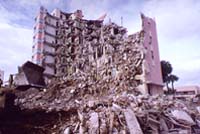
|
| Summary Statement: The Success Needs To Be Nurtured | |
| Miami Beach has learned the value of protecting its architectural heritage, as this heritage has been the catalyst for the city's latest boom. The world now recognizes Miami Beach's signature statement, its thriving Art Deco District. With success comes a new challenge. We must be ever-vigilant in protecting the atmosphere that has been created. We must reject the efforts of those who wish to over-build and over-commercialize our popularity. The City emerged too rapidly over the past five years, and we must be respectful of the infrastructure that supports it while recognizing its limitations as an historic area. Let us consider the City's past history and never allow this to become the City's final bust. | |
| Universal Lessons | |
| Cities of quality preserve the past and use it as a guide to build the future. | Cities of quality preserve the past and use it as a guide to build the future. Historic Districts and Heritage Tourism are a phenomenon as well as an economic success. Cities must have an identity to distinguish them from the rest. |
| Nancy Liebman |
![]()
![]()
 |
 |